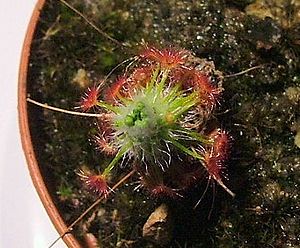
Drosera pedicellaris
Encyclopedia
Drosera pedicellaris is a pygmy species of the sundew
genus (Drosera). It was discovered in 1997 and described in 2002 by Allen Lowrie
.
, up to 1.5 centimetres tall and with a diameter of up to 1.8 centimetres. Like all pygmy sundews, it is able to reproduce asexually by producing gemmae in autumn.
s are 4–5 mm. long, 0.8 mm. wide at the base and narrowing to 0.1 mm. width before the lamina. The lamina is suborbicular and has a diameter of about one millimetre.
s, rising up to five centimetres high and bearing up to twenty flowers. These have five white petal
s with a green section at the base, each up to 3.5 millimetres long. The pollen is orange. The flowers have an unusually long pedicel
, the ellipsoid seeds are 0.5 millimetres long.
 There are only two known populations of Drosera pedicellaris, both southwest of Geraldton
There are only two known populations of Drosera pedicellaris, both southwest of Geraldton
near Three Springs
in Western Australia
. It grows on beige sand heath, accompanied by low shrubs.
As almost nothing is known about possible further sites and the species itself requires further research, it has been declared as Priority One - Poorly Known Taxa by the Western Australian Department of Environment and Conservation.
This plant is also found in the stirling ranges east of Perth city in Western Australia.
The epithet pedicellaris refers to the plant's unmistakably long pedicel.
Sundew
Drosera, commonly known as the sundews, comprise one of the largest genera of carnivorous plants, with at least 194 species. These members of the family Droseraceae lure, capture, and digest insects using stalked mucilaginous glands covering their leaf surface. The insects are used to supplement...
genus (Drosera). It was discovered in 1997 and described in 2002 by Allen Lowrie
Allen Lowrie
Allen Lowrie is a West Australian botanist. He is living in Duncraig, a Perth suburb, is married and has two daughters.Lowrie, originally a businessman and inventor, got in contact with the carnivorous flora of western Australia in the late sixties and worked on it as an amateur...
.
Description
The plant forms a ground-hugging rosetteRosette (botany)
In botany, a rosette is a circular arrangement of leaves, with all the leaves at a single height.Though rosettes usually sit near the soil, their structure is an example of a modified stem.-Function:...
, up to 1.5 centimetres tall and with a diameter of up to 1.8 centimetres. Like all pygmy sundews, it is able to reproduce asexually by producing gemmae in autumn.
Leaves
The plant has up to twenty leaves, which are semi-erect in the rosette's centre and almost horizontal at the plant margin. The slightly hairy petiolePetiole (botany)
In botany, the petiole is the stalk attaching the leaf blade to the stem. The petiole usually has the same internal structure as the stem. Outgrowths appearing on each side of the petiole are called stipules. Leaves lacking a petiole are called sessile, or clasping when they partly surround the...
s are 4–5 mm. long, 0.8 mm. wide at the base and narrowing to 0.1 mm. width before the lamina. The lamina is suborbicular and has a diameter of about one millimetre.
Inflorescence
In October / November the plant produces one to three cymes with thin bracteoles on filiform inflorescenceInflorescence
An inflorescence is a group or cluster of flowers arranged on a stem that is composed of a main branch or a complicated arrangement of branches. Strictly, it is the part of the shoot of seed plants where flowers are formed and which is accordingly modified...
s, rising up to five centimetres high and bearing up to twenty flowers. These have five white petal
Petal
Petals are modified leaves that surround the reproductive parts of flowers. They often are brightly colored or unusually shaped to attract pollinators. Together, all of the petals of a flower are called a corolla. Petals are usually accompanied by another set of special leaves called sepals lying...
s with a green section at the base, each up to 3.5 millimetres long. The pollen is orange. The flowers have an unusually long pedicel
Pedicel (botany)
A pedicel is a stem that attaches single flowers to the main stem of the inflorescence. It is the branches or stalks that hold each flower in an inflorescence that contains more than one flower....
, the ellipsoid seeds are 0.5 millimetres long.
Distribution, habitat and status

Geraldton, Western Australia
Geraldton is a city and port in Western Australia located north of Perth in the Mid West region. Geraldton has an estimated population at June 2010 of 36,958...
near Three Springs
Three Springs, Western Australia
Three Springs is located 313 km north of Perth, Western Australia on the Midlands Road. Wheat farming is the main industry.The first Europeans to pass through the Three Springs area were Lieutenant George Grey and his party in 1839. The next exploration of the area in 1846 was undertaken by...
in Western Australia
Western Australia
Western Australia is a state of Australia, occupying the entire western third of the Australian continent. It is bounded by the Indian Ocean to the north and west, the Great Australian Bight and Indian Ocean to the south, the Northern Territory to the north-east and South Australia to the south-east...
. It grows on beige sand heath, accompanied by low shrubs.
As almost nothing is known about possible further sites and the species itself requires further research, it has been declared as Priority One - Poorly Known Taxa by the Western Australian Department of Environment and Conservation.
This plant is also found in the stirling ranges east of Perth city in Western Australia.
Taxonomy and etymology
Drosera pedicellaris is part of the large group of the so called "pygmy sundews", which form the genus' section Bryastrum. It is closely related to Drosera parvula.The epithet pedicellaris refers to the plant's unmistakably long pedicel.

